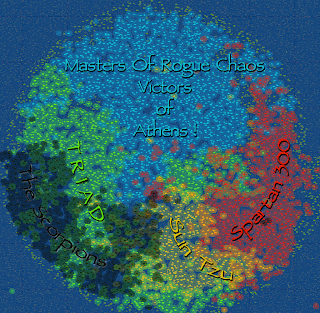 |
| Figure 1 |
All this takes place on a server, known as a "world" and is populated by thousands of real players from different countries. The immersive potential of this most simplistic of virtual environments cannot be underestimated. In fact, "our capacity to immerse ourselves in a symbolic element has developed to where we hardly even notice the disappearing act" Heim (1993). Its when this "disappearing act" begins to interfere with RL (real life) commitments that a player has to re-evaluate their self imposed captivity - punishment is now a real possibility from external factors.
Grepolis relies heavily on a "world" map for gameplay. A player must amass multiple cities, located on multiple islands within this map. Wood (2006) points out the importance of maps by stating, "Every map serves a purpose, every map advances an interest" (p.4). This can be seen clearly in the map driven gameplay of Grepolis, rewarding those players who master it. Furthermore, maps shape understandings of space, place and power (Petray, 2013, 3.1 Maps), ref to figure 1, showing the top 5 alliances on one of the many Grepolis servers.
Although Prouty (2009) might think "the flâneur as an historical figure ended ignobly", it's genesis lives on, nobility restored, and free to roam cyberspace, or the world map of Grepolis as freely as the arcades of yesteryear.
References
Barnes, G. (1997). Passage of the Flaneur. Retrieved from http://www.raynbird.com/essays/Passage_Flaneur.html
Heim, M. (1993). The metaphysics of virtual reality. New York: Oxford University Press
Prouty,R.(2009). A Turtle on a Leash. Retrieved from http://www.onewaystreet.typepad.com/one_way_street/2009/10/a-turtle-on-a-leash.html
Petray, T. (2013, 3.1 Maps). BA1002: Our Space: Networks, Narrative and the Making of Place, week 3. [Audio Recording]. Retrieved from http://learnjcu.jcu.edu.au
Petray, T. (2013, 3.1 Maps). BA1002: Our Space: Networks, Narrative and the Making of Place, week 3. [Audio Recording]. Retrieved from http://learnjcu.jcu.edu.au
Wood, D., & Kaiser, W. L. (2006). Seeing through maps: many ways to see the world. Oxford: New Internationalist.
Image Credit
Figure 1, World Map in Grepolis. Retrieved from: http://i882.photobucket.com/albums/ac28/philipv/AthensFinalMap.gif
Thank you for your post Luke. I find the differentiations between what we have observed within our social networks intriguing. You quoted Barnes arguing “Cyberspace is a prison” (1997), yet I am perceiving the opposite outcome within my chosen network ‘Between the Bars’ (BTB) which displays blog posts hand-written by actual prisoners currently detained in American prisons.
ReplyDeleteThroughout BTB, I have observed cyberspace facilitating virtual freedom for individuals serving terms of imprisonment which for some, is their only link with the outside world.
As you pointed out in your post, Barnes speaks of ‘captivity without boundaries’ when referring to cyberspace, but cyberspace interestingly provides previously unattainable freedoms for BTB bloggers who have no direct internet access . Cyberspace has offered these inmates a loophole, bridging the communication divide and where you have viewed participants on the Grepolis network perform a “disappearing act” into a virtual reality; in contrast, I believe the participants on BTB are performing an escape act as many tell of how their blogs are an escape of the mind, an escape from their physical surrounds, finally giving them the ability to ask questions and seek mental stimulation while making new contacts, which previously has not been possible.
REFERENCES
Barnes, G. (1997). Passage of the Cyber-Flaneur . Retrieved from http://www.raynbird.com/essays/Passage_Flaneur.html